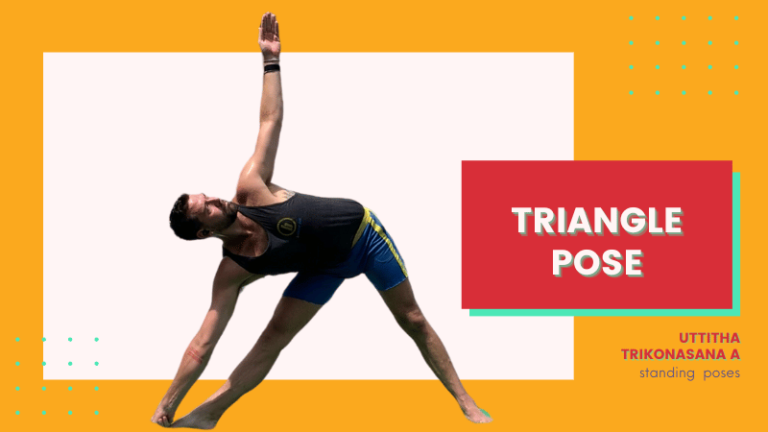Uttitha Trikonasana B Cues
Internal Cues:
- Back Foot Supination: Focus on the sensation of the outer edge of your back foot slightly lifting as it turns inward.
- Front Foot Rotation: Feel your front foot actively rotating outward, laying flat and stable at a 90-degree angle.
- Back Hip Extension: Be aware of extending through your back hip, feeling a lengthening and opening sensation.
- Front Hip Flexion: Tune into your front hip as it flexes, aligning with the rotation of your front foot.
- Knee Extension: Concentrate on straightening both knees, creating a sense of length and stability in the legs.
- Trunk Flexion and Rotation: Notice the side of your trunk stretching as you laterally flex and gently rotate, creating space in your torso.
- Upper Shoulder Movement: Be mindful of your upper shoulder moving outward (externally rotating) and upward (abducting), opening up your chest.
- Lower Shoulder Movement: Feel your lower shoulder rotating inwardly (internally rotating) and lifting slightly (abducting), engaging the muscles across your back.
- Cervical Spine Rotation: Pay attention to the rotation in your cervical spine as you turn your head upward, aligning it with your spine.
External Cues:
- Back Foot as a Pivot Point: Imagine your back foot acting as a stable pivot point, anchoring you into the ground.
- Front Foot as a Directional Guide: Visualize your front foot as a compass pointing straight ahead, guiding the alignment of your pose.
- Back Hip as a Driving Force: Think of your back hip as a driving force, pushing energy backward to enhance the pose’s stability.
- Front Hip Leading the Movement: Picture your front hip leading the forward movement, guiding the rotation and alignment of your torso.
- Legs as Pillars of Strength: See your legs as strong pillars, grounding you and supporting the entire structure of the pose.
- Trunk as a Flexible Branch: Imagine your trunk like a flexible branch, bending and twisting with ease and control.
- Upper Shoulder as a Wing: Envision your upper shoulder as a wing, spreading wide to open up your chest and heart space.
- Lower Shoulder as a Counterbalance: Think of your lower shoulder as a counterbalance, helping to stabilize and distribute your body weight evenly.
- Head as a Beacon: Visualize your head as a beacon, shining upwards, guiding your gaze and aligning your neck gracefully.
These cues are crafted to address each anatomical aspect of the pose, guiding practitioners to deepen their practice through heightened body awareness and spatial orientation.







